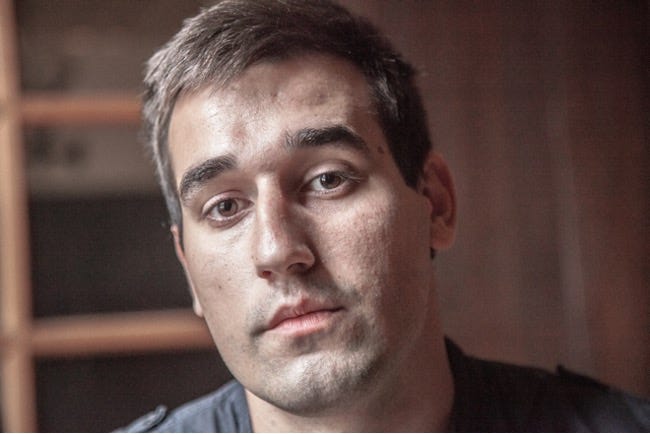ONE DIMENSIONAL PHOTOGRAPHS
I am concentrating on the digital negative and edited print of this image.

Why am I addressing this question of photo-editing?
Because it offers several ideas to be considered.
Some of these ideas are about finding meaning in existence
and some are directly about creative processes.
NEGATIVE AND POSITIVE
Note that the negative is tonally flat, without contrast,
with the important areas of the subject’s face
too bright, placed too high in the mid-tones and lacking interest.
Note that the walls behind loosen one’s visual attention
and that the overall salmon colour not only does not add to the image
but distracts from it.
This picture is from a series of photographs I made for a TCFT project.
What then was my role?
To simply photograph the people posing or to try to capture the invisible distinction
in each of the sitters?
This leads to the underlying approach:
do I photograph the surface of events
or do I attempt to capture the emotional meaning of the event?
I decided years ago that my best pictures would emerge
from concentrating on the emotions; that I would photograph the emotions,
and I would create common cause between myself and the person in my frame
to make the apparently invisible become visible.
And yes, I turned the image into a more refined, less distracting,
graphically stronger almost duo-chrome image.
and yes, I purposely darkened the highlights pouring through the window
to enclose and visually entrap the sitters.
For me, the bland digital negative
was creatively transformed into a piece of social engagement.
BEING A DOCUMENTARIST
All my adult life I have avoided the title ‘artist’.
This is because, since my rebellious teenage years
and still today,
I have associated the word with one of three conditions.
•The first is that to me the title belongs to painters and sculptors.
•The second is that all too often it seemed to me
that those calling themselves artists were preoccupied with self-expression
rather than with social change.
Their creative commitment was to themselves rather than to the society.
•The third is that the title seemed too grandiose and too generalised
for me as a photographer and film-maker.
I am okay in calling myself ‘photographer‘, or ‘film-maker’
or more accurately, ‘documentarist’.
I’ve written of this before,
that as a photographer or film-maker
one must be at the place of the initial ‘making’
where the event to be documented or the thing happens or exists.
A painter or composer,
a poet or novelist can encounter something for a moment,
depart and reconstruct the sense of the thing in the quiet of their loft,
whereas the documentarist must attend, must stay the course
to capture the initial recording.
Later I can make something more of it:
I can enunciate its reality, its sense of being, its presence
through manipulating the colour, hue, tone, contrast, crop, sharpness
and of course its juxtaposition to texts and other photographs,
or in the case of a film, the shot’s role in the edit
and of course any associated sounds.
TRUTH AND BEAUTY
What I have learned in my working life
is that the arts foretell and reflect change.
And I know that I practice a poetic or lyrical realism,
and that my earlier vague explanations to myself
about how to define my work,
appeared to be consistent
with what I read of Herbert Marcuse’s (see below) definition of aesthetic form.
I have never been a reporter, interested in documenting the surface of events.
The poetic element enters
when Content is chosen from social reality,
transformed by my creative intentions
into a photograph, film or an essay/story that renders aesthetic form.
This form carries the centre of meaning capable of touching other’s needs.
This conjunction between the viewer’s troubling needs
and my work is where they may discover truths.
This is where the audience, cry or laugh or grasp their hearts.
This is where the audience say, ‘this is beautiful’.
content transformed
via creative intentions
= aesthetic form
= beauty
= truths
My content is reality intensified and personalised through the aesthetic from,
that is via my visual language.
Using composition, colour, tonality and subject
it is transformed into poetic form; the subject becomes a metaphor,
it stands in for something more important or profound than it in itself.
I admit that while I have shied away from the title ‘artist’
I have quietly, and to myself,
referred to what I do as ‘poetic’,
searching for making that vital contribution that will address other’s needs
and touch other’s souls to encourage change.
I am less interested in mediating facts,
that is, I am disinterested in relating to others what the world seems to be
on its surface.
THE ACTIVE ROLE OF AESTHETICS
What can be done on a practical level to change the world via the arts?
Herbert Marcuse, the philosopher
and author of THE ONE DIMENSIONAL MAN,
wrote that even contemporary philosophy has rejected happiness.
He went on to write about aesthetics being the only activity we have
that can re-create a complex multidimensional world.
Complexity is always the enemy of populism
and any form of totalitarian government.
That is why the agitators and mouthpieces of those regimes hate questions (and questioners),
but who better to pose questions than artists?
I’d say that poets, journalists, some lawyers and academics
all play a role, although they differ from each other.
But if artists and documentarists do not investigate reality,
do not test it, do not ask questions of it
they are only decorators or entertainers.
NOTES




